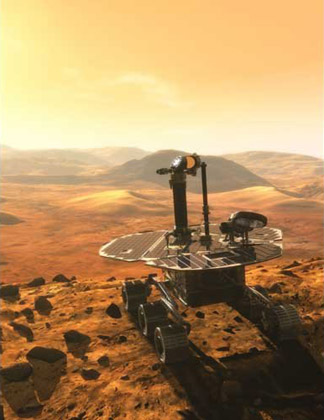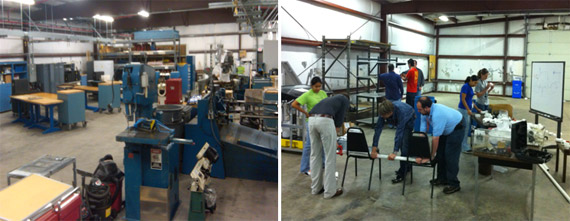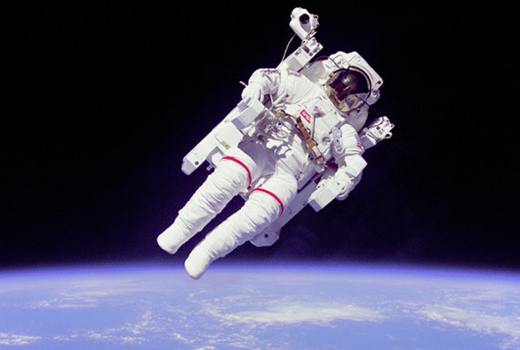NASA’s Social Innovation Concept: Human Development & Space Exploration
NASA Johnson Space Center’s (JSC) social innovation concept encourages out-of-the-box problem solving within the NASA community to benefit both NASA’s core mission and humanity’s most pressing needs. Because human space exploration technologies share similar requirements with developing world technologies, the program goal is to provide non-traditional collaboration and diverse resources to encourage multi-disciplinary solutions. For instance, the technology goals of keeping people alive in a difficult environment involve addressing requirements for low maintenance and robustness, and often include using renewable energy sources. Problem solving for such challenges has crossover benefits, which is why innovation in one engineering field may be applicable to another. Therefore, the JSC social innovation concept is an alternative method of developing expertise within the NASA community, which can simultaneously demonstrate relevance as it contributes to improving life on Earth. By recognizing that innovation can come from unexplored and unexpected places, this concept aims to create an environment where NASA engineers can collaborate with non-traditional partners to address the critical needs of NASA and its many stakeholders.
The 1969 Apollo Moon landing captured the imagination of the world as it collectively saw what humans are capable of – according to Astronaut Neil Armstrong, “That’s one small step for Man, one giant leap for Mankind.” As a result, NASA has solved in the past and can solve in the future the toughest challenges of human exploration. However, today at the start of 2012, NASA is at a crossroads. As commercial and international access to Low Earth Orbit (LEO) becomes more commonplace, America’s space agency is looking toward the huge technological challenges of taking humans to remote, harsh and resource-constrained environments for long time periods.
Human space exploration has been primarily limited to LEO for the past 50 years. With the exception of the 1960s’ and 1970s’ Apollo missions, humans have explored space within a few hundred miles of the Earth’s surface. LEO is where the space shuttle flew and where the International Space Station (ISS) currently is. Even in the Apollo moon missions, while physically distant, U.S. astronauts were on missions measured in days.
Flying in, to and from space is an incredibly challenging task. It takes enormous amounts of energy to move a payload from the Earth’s surface to velocities and altitudes sufficient enough to reach LEO. Once in the vacuum of space, sustaining human life is not easy; it is a harsh environment in just about every respect. Life support equipment (air, water, food, waste, medical, etc.) is essential. Today these systems work well enough, but they are complex and expensive. And, they require consumables, resupply and maintenance. Returning humans to Earth is also difficult because the spacecraft must protect the occupants from extreme temperatures as they decelerate from orbital speeds of 18,000 mph to zero.

Milky Way Illustrated
As difficult as these challenges are in LEO, those of sustaining human life on missions to remote locations like Mars are even more difficult. A Mars mission may take years, and the distances involved and the nature of orbits are such that rescue or evacuation will be impossible.
The tough technical challenges engineers will confront for a long duration, remote, human space exploration mission are not very different from challenges that continue to exist for much of the world’s population. Clean water and air, and access to nutritious food, healthcare and waste management are obvious common needs. Systems along these lines will need to be more similar to those needed for remote earthbound locations, which is why alternative methods for developing technologies and expertise within the NASA community are needed.
Shared Terrestrial & Spacecraft Challenges
President Obama has directed NASA to develop technologies for space exploration that can also benefit life on Earth. In an April 2010 message at NASA Kennedy Space Center, Obama stated: “. . . we will extend the life of the International Space Station likely by more than five years while actually using it for its intended purpose: conducting advanced research that can help improve the daily lives of people here on Earth as well as testing and improving upon our capabilities in space. This includes technologies like more efficient life support systems that will help reduce the cost of future missions.” The President continued by commenting that “our goal is the capacity for people to work and learn and operate and live safely beyond the Earth for extended periods of time, ultimately in ways that are more sustainable and even indefinite.”
Long-duration spaceflight, as anticipated for planetary missions, will require hardware that is less prone to failure and generally more rigorous and sustainable than what is currently state-of-the-art. New life support systems need to function for long time periods in harsh environments with limited maintenance and resupply. Water recovery, air revitalization, habitation, food and power systems may benefit from considering sustainability as a deliberate design goal. While life support resources, such as water and air, will remain in short supply, the availability of gravity, energy and natural resources on the planetary surface allow for design innovation of outpost technologies, potentially benefiting from solutions to Earth’s remote needs.
Technologies developed for human space exploration – i.e., keeping people alive in remote environments – have crossover benefits with other engineering fields, which include solar power, ultraviolet disinfection and reverse osmosis membranes. For example, spacecraft wastewater streams are similar in contaminants and purification needs to those in developing world surface and ground water, thus making water recovery systems a high potential area for collaboration and mutually beneficial innovation.
The U.N. Millennium Development Goals (MDG) present a well-accepted summary of global needs and challenges – food, poverty alleviation, health, sustainable energy, clean air and global partnerships. As stakeholders consider the billions of people who live in remote areas without access to healthcare, clean water, energy or even clean air, it is clear that the challenges of remoteness are tough. Neither NASA nor the global development community have been able to solve them yet. Figure 1 maps some of the MDG to NASA’s long-duration spacecraft needs, highlighting similarities between these applications. Although specific technical innovations may be connected across several common needs, it is useful to consider how much overlap exists between NASA’s mission and the world’s development needs.

Photo Credit: NASA Space Johnson Center|Figure 1. Comparison of U.N. Millennium Development Goals with NASA’s space technology grand challenges as identified by NASA’s Office of the Chief Technologist. Thematic connections are for illustration only.
Rationale
Space exploration is inherently borderless. One common observation made by returning first-time space fliers is how striking it is to see Earth without political boundaries drawn on maps. It is also common to hear how fragile Earth looks with its thin blanket of air, which is the only thing separating its inhabitants from the harsh vacuum and temperature extremes of space. No other area of national policy allows for so little intrinsic emphasis on borders. In addition, the language of math and science easily transcend the usual limitations of spoken and written language.
America’s leadership in space gives it the potential to engage in noble and pure diplomacy targeted at the creative, dreaming and educational aspects of childhood and adolescence. America’s 15 partner nations in the ISS Program would be a good start to the multilateral effort to enhance education. Science, math, rockets and spaceships are compelling enough in the “science as diplomacy” argument. However, another opportunity exists to engage those at the “base of the pyramid” in rural, remote and harsh environments to work together to solve the toughest technical and sociological challenges in the human experience. Such engagement could be facilitated by intermediaries already engaged with remote communities to help innovate and design solutions to these mutual problems.
Workforce Development & Retention. NASA is one example of a large and increasingly bureaucratic organization, which could benefit from revitalization and a renewed source of creative spirit and innovation. An increasing desire exists among its workforce to contribute to goals larger than itself and to make a positive contribution to humanity and the environment. A deliberate collaboration with the global development community and with people in remote parts of the world would improve retention for the professionals NASA most wants to keep – those who think out-of-the-box and who are predisposed to work hard to solve tough problems.
Terrestrial Engineering Applications. NASA has an impressive history of producing technological advancements that improve life on Earth. For instance, cell phones, microelectronics, lightweight materials and many medical devices benefit from NASA “spinoffs.” However, important distinctions in the development of NASA’s technologies make solving the developing world’s challenges unlikely. For instance, for a human space mission, the tolerance for failure is low, which is why NASA pays great costs to ensure a given technology works. LEO mission requirements and a lack of cost discipline result in understandably high program costs and, in many cases,overdesign and high system complexity.
In contrast to NASA “spinoffs,” it is the “spin-in” technologies that may be most interesting. In other words, bottom-line NASA benefits may come from advancements made and lessons learned from developing world problem solving, which are applied to design and technology for future exploration missions. For example, it may be that the Opuntia cactus, which is used in rural Mexico as a nutrient, coagulant and fiber source, is an ideal plant to be grown in space because it requires very little water to grow and yet provides many benefits. Or, perhaps the refrigeration technique used in Africa, where two inset clay pots surrounded by water yield evaporative cooling effects, could be the basis for a zero-power and simple refrigerator for astronauts on Mars. NASA should be on the look-out for these types of solutions that already exist on the planet and apply them to humankind’s space exploration goals.
A deliberate engagement with the global community could involve sending NASA engineers on training and development assignments to work alongside sustainable engineers and other professionals tackling remote community challenges in energy, water and healthcare diagnostics and delivery.

Photo Credit: NASA/courtesy of nasaimages.org|Comms Relay for Mars Landers & Rovers
NASA already pays to train its engineers in classrooms across the country; certainly one can argue that hands-on experiential learning assignments can be at least as valuable, if not more. This innovative training methodology would not increase taxpayer contribution, but it would increase taxpayer benefit with a double or triple benefit payback thanks to increased multi-disciplinary effectiveness and appropriateness in workforce training.
Imagine a NASA engineer, whose job is to eventually design power and energy systems for a two-year Mars mission, investing six months alongside sustainable professionals working to provide reliable power to a remote village. This “tiger” team of creative engineers will have to think about remoteness, scarcity of materials and spare parts, and lack of specialist repair services, among other challenges. The team will also forge lasting relationships that may lead to future as-of-yet-unimagined inventions and useful projects. And, that NASA engineer will return to the Agency more experienced and creative with a robust and non-traditional perspective on systems engineering in remote locations. Outside of sending the engineer to Mars, this would be the next-best training. Other organizations (governmental or non-governmental) could also benefit as this type engagement will also stimulate creativity and innovation in their workforce.
Current Social Innovation Activities
Collaboration with USAID. The relatively recent shift in NASA and Administration priorities has led to high-level discussions and collaborations between NASA and the U.S. Agency for International Development (USAID), including a recently signed memorandum of understanding . First, the two agencies have hosted three successful high-level “LAUNCH” workshops , which is a global initiative by NASA, USAID, U.S. Department of State and NIKE to bring attention to global challenges through a series of forums. The first forum focused on clean water and brought 10 top innovators to Kennedy Space Center to discuss their approaches and to interact with each other, thus creating new partnerships and interactions in the process. The second forum addressed human health and also invited the top innovators in the field to interact with sponsor agencies and each other. The third forum focused on clean energy. The SERVIR initiative is another collaboration component between NASA and USAID, which integrates satellite observations, ground-based data and forecast models to monitor and forecast environmental changes, and to improve natural disaster response.
One potential collaboration area between USAID and NASA is oriented toward identification of potential spin-off technologies for the developing world. Other discussions have focused on the potential for employee rotational assignments between USAID and NASA. In the authors’ opinion, the potential for interaction between the two agencies lies in the degree to which the best and the brightest from each organization can come together on-the-ground and get their hands dirty in the tough problems of common interest.
Collaboration with Engineers Without Borders. The Engineers Without Borders-USA Johnson Space Center Chapter is an association of Johnson Space Center (JSC) employees, contractors and other professionals in the Houston/Clear Lake area who volunteer off-duty time to participate in projects and efforts of Engineers Without Borders-USA. The JSC Chapter has had dedicated volunteers contributing time and resources to programs in Rwanda and Mexico since 2004. Many volunteer NASA engineers have commented that by directly engaging in the concept, design and implementation of a technology solution in a developing country, they have built critical engineering skills benefitting their day jobs at NASA.
JSC’s Innovation Design Center (IDC) “Sandbox.” It is in NASA’s interest to enable civil servant and contractor volunteers to create and to innovate in a safe environment for causes of mutual interest to the Agency and the global development community. As mentioned, many of NASA’s toughest technical challenges are related to future long-duration human exploration missions to remote and resource-constrained environments. While resources such as clean water, air, energy and healthcare will be limited on such missions, so will the ability to resupply and repair. On Earth these challenges exist in some areas of the U.S. and in many areas of the developing world. Employees volunteering to address these terrestrial challenges will be better able to contribute to NASA’s ability to solve these same challenges beyond LEO.
IDC, or “Sandbox,” is a NASA-JSC pilot facility developed by a team that includes the authors, whose purpose is to encourage and to facilitate JSC employees to get hands-on experience with designing, building and testing innovative technologies pertaining to NASA’s mission. IDC offers a safe place for JSC engineers to create and to collaborate with non-traditional partners with whom they would not otherwise interact, as well as a space where hands-on training on machine shop tools and fabrication is provided in an action-learning environment.

Photo Credit: NASA Space Johnson Center|Figure 2. The Johnson Space Center Innovation Design Center (IDC).
A candidate pilot program for IDC included four phases. The initial planning phase aimed to develop the project challenge (mutual need of the development community and NASA), to identify a JSC community “A-team” to work on the challenge and to establish partnerships with organizations to provide immersion opportunities. The first operational phase would pitch the JSC team against volunteer, high school, university, company and non-profit teams competing in the design challenge. The JSC team would develop their technology openly, which includes publishing designs and testing results. At the end of this phase, the JSC team will be judged alongside other entrants. In the following phase, the JSC team is proposed to travel to immersion locations to further develop expertise and experience in specific challenge-related fields.
For example, a water recovery project may place JSC engineers in Bangladesh with a non-profit treating arsenic in the surface water or in Israel at a major seawater desalination plant. In the final phase, the JSC team will reconvene to develop a higher fidelity technology. The latter will, hopefully, integrate results and experience gained through the challenge and immersion phases to deliver a technology worthy of integration into NASA’s mainstream activities. The technology development efforts would also, hopefully, directly benefit human life in resource-constrained environments on Earth. Such an initiative is just one example of how NASA could engage creatively with a multitude of stakeholders in a mutually beneficial manner.
Conclusion
NASA’s and the developing world’s most pressing needs are becoming synergistic and complementary with respect to technology development. As a result, engineers will require never-before-experienced collaboration with governmental and non-governmental organizations in order to solve these problems. Within a resource constrained world that is experiencing increasing climate change, creative, out-of-the-box solutions will become the mainstay for tomorrow’s challenges.
A new learning philosophy is necessary to encourage this evolving and multi-disciplinary way of thinking as engineers begin to understand that new methods for designing and problem solving can and will come from anywhere – from a young girl in a rural African village to a Fortune 500 marketing executive to an inner-city secondary school student. Collaboration, information and vision-sharing are required today to address NASA’s critical needs of tomorrow while simultaneously demonstrating its relevance and contribution to improving life on Earth





























